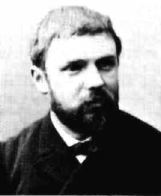

Henri Poincaré entered the Ecole Polytechnique in 1873. He continued his studies at the Ecole des Mines as a student of Hermite, and
received his doctorate in mathematics in 1879. He was appointed to a chair of mathematical physics at the Sorbonne in 1881, a position he held until his death.
Before the age of 30 he developed the concept of automorphic functions which he used to solve second order linear differential equations with algebraic coefficients. His Analysis situs, published in 1895, is an early systematic treatment of topology. Poincaré can be said to have been the originator of algebraic topology and of the theory of analytic functions of several complex variables. He also worked in algebraic geometry and made a major contribution to number theory with work on Diophantine equations.
In applied mathematics he studied optics, electricity, telegraphy, capillarity, elasticity, thermodynamics, potential theory, quantum theory, theory of relativity
and cosmology. In the field of celestial mechanics he studied the three-body-problem, and theories of light and electromagnetic waves. He is acknowledged as a co-discoverer,
with Albert Einstein and Hendrik Lorentz, of the special theory of relativity. He is often described as the last universalist in mathematics.
In his first major work published between 1892 and 1897, he aimed to completely characterise all motions of mechanical systems. He invoked an analogy with fluid flow. He also
showed that previous series expansions used in studying the 3-body problem were convergent, but not in general uniformly convergent, so putting in doubt the stability proofs of Lagrange and Laplace. He also wrote many popular scientific articles.
Poincaré introduced the fundamental group to
distinguish different categories of two-dimensional surfaces. He was able to show that any 2-dimensional surface having the same fundamental group as the
two-dimensional surface of a sphere is topologically equivalent to a sphere. He conjectured that the result held for 3-dimensional manifolds and this was later extended to higher dimensions.
Now called the Poincaré conjecture, this is one of the most baffling and challenging unsolved problems in algebraic topology.
Poincaré was also first to consider the possibility of chaos in a deterministic system, in his work on planetary orbits. Little interest was shown in this work until the
modern study of chaotic dynamics began in 1963.